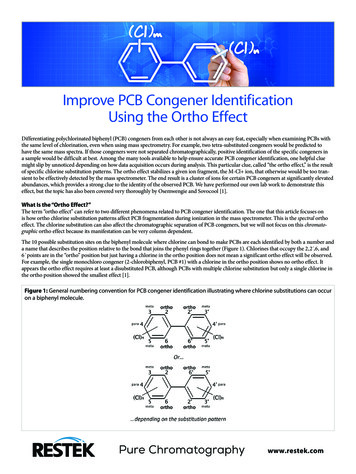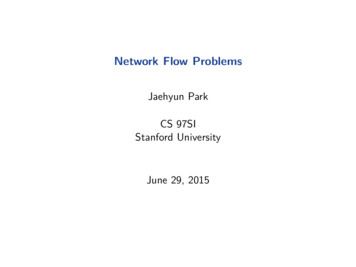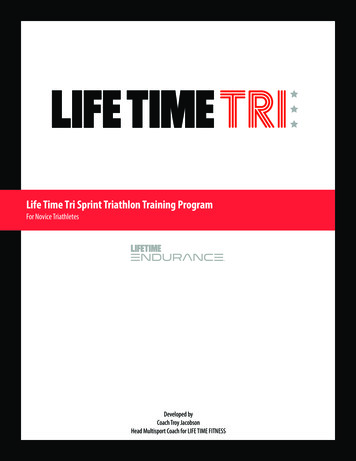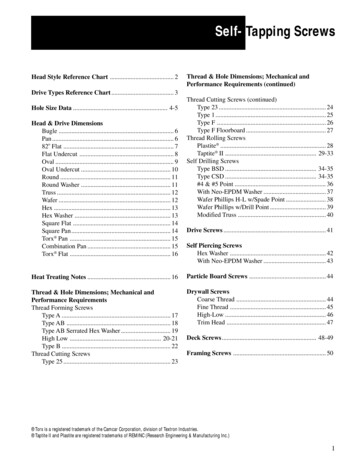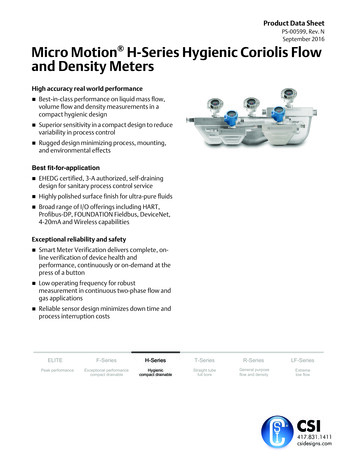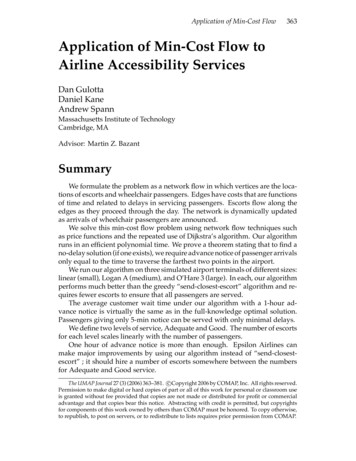
Transcription
Application of Min-Cost Flow363Application of Min-Cost Flow toAirline Accessibility ServicesDan GulottaDaniel KaneAndrew SpannMassachusetts Institute of TechnologyCambridge, MAAdvisor: Martin Z. BazantSummaryWe formulate the problem as a network flow in which vertices are the locations of escorts and wheelchair passengers. Edges have costs that are functionsof time and related to delays in servicing passengers. Escorts flow along theedges as they proceed through the day. The network is dynamically updatedas arrivals of wheelchair passengers are announced.We solve this min-cost flow problem using network flow techniques suchas price functions and the repeated use of Dijkstra’s algorithm. Our algorithmruns in an efficient polynomial time. We prove a theorem stating that to find ano-delay solution (if one exists), we require advance notice of passenger arrivalsonly equal to the time to traverse the farthest two points in the airport.We run our algorithm on three simulated airport terminals of different sizes:linear (small), Logan A (medium), and O’Hare 3 (large). In each, our algorithmperforms much better than the greedy “send-closest-escort” algorithm and requires fewer escorts to ensure that all passengers are served.The average customer wait time under our algorithm with a 1-hour advance notice is virtually the same as in the full-knowledge optimal solution.Passengers giving only 5-min notice can be served with only minimal delays.We define two levels of service, Adequate and Good. The number of escortsfor each level scales linearly with the number of passengers.One hour of advance notice is more than enough. Epsilon Airlines canmake major improvements by using our algorithm instead of “send-closestescort” ; it should hire a number of escorts somewhere between the numbersfor Adequate and Good service.cThe UMAP Journal 27 (3) (2006) 363–381. Copyright2006 by COMAP, Inc. All rights reserved.Permission to make digital or hard copies of part or all of this work for personal or classroom useis granted without fee provided that copies are not made or distributed for profit or commercialadvantage and that copies bear this notice. Abstracting with credit is permitted, but copyrightsfor components of this work owned by others than COMAP must be honored. To copy otherwise,to republish, to post on servers, or to redistribute to lists requires prior permission from COMAP.
364The UMAP Journal 27.3 (2006)IntroductionAnnually, 2.2 million disabled people over the age of 65 travel [Sweeney2004]. Major airlines provide wheelchairs and escorts (attendants) for disabledpassengers but struggle to manage costs. We consider how few escorts areneeded and how best to route them through the day. The algorithm should beflexible enough to deal with incomplete information about the arrival times ofpassengers or with an unexpected arrival. We recast the problem as a min-costflow problem, the daily schedule of the escorts being the network flow.Terminology and Conventions Job. The process of an escort picking up a wheelchair passenger (WP) at anarrival gate and taking them to their connecting departure gate. Job starting time. The time when a WP arrives at the airport. If an escortbegins a job after the starting time, the WP had to wait before being helped. Job ending time. The time at which a WP needs to be at the departure gateto board in a timely manner. If an escort cannot finish a job after the endingtime, the passenger misses their plane entirely! Vertex and Edge. Our airport is set up as a graph that used for distancecalculations. Our algorithm is set up as a min-cost flow problem on a networkthat uses a completely unrelated graph. Price, Cost, and Effective Cost. We use the standard graph-theory definitions for these words, not business definitions. Price and cost are not thesame thing: Cost is the penalty for performing jobs (which is negative, sincewe want people to perform jobs), while price is an artificial construct thatwe need to run Dijkstra’s algorithm.Assumptions and Assumption JustificationsAbout Airports and Flights In our airport graphs, each edge has uniform density of gates. This isnot always the case in real life, but the mathematics of our model wouldnot change if this assumption were removed, only the maps used in itsimplementation. The passengers’ flight connections go between random gates. Since passengers may be connecting a wide variety of places, the airline cannot optimize for all the distances between departure and arrival gates.
Application of Min-Cost Flow365 Arrival times and gates do not change less than 1 h before arrival; departuretimes and gates do not change less than 3 h before departure. We permitplanes to be delayed or have gates changed but not while an escort is helpinga WP or moving to pick up a WP. This assumption is not fully realistic, butit should not affect our end results too much and it makes the model easierto implement. We can still have the unexpected arrival of WPs. All passengers are making connections, not arriving at their final destinations. This assumption is unrealistic, but our model could easily be changedto handle final destinations as well, by adding a gate to represent the baggageclaim and having passengers depart from this gate. Effective layover times range from 45 min to 132 min, linearly biased towards shorter layover times. Effective layover time means that we take intoconsideration that WPs are usually the last to deboard and the first to board.These times are arbitrary, not based on empirical data. The distribution of WPs on flights is random. There is no tendency forsuch passengers to travel in groups. Although this assumption might befalse around the time of the Special Olympics or other specific events, for atypical day it is reasonable.About Escorts Escorts receive orders via computer. Communication of orders to escorts isfast and robust, and a computer runs the algorithm. Escorts all walk at the same pace. A typical modeling assumption. Escorts travel half as fast when a person occupies the wheelchair as withan empty wheelchair. The factor of two is arbitrary, in the absence of data. The level of traffic in the airport does not affect travel times within theairport. We make this assumption so that when we analyze our results weavoid confounding the effects of increasing the number of WPs in the airportwith the effects of changing the airport layout. Escorts do not abandon WPs. Regulations prohibit airlines from leaving apassenger in a wheelchair unattended for more than 30 min [U.S. Departmentof Transportation n.d.]. Such a passenger may still require transportation torestrooms. The escort remains on hand until the passenger boards, when theflight crew takes over. So each escort pushes a single wheelchair that neverleaves their sight (hence less concern about loss of equipment).
366The UMAP Journal 27.3 (2006)Cost StructureWe tabulate statistics on the delays in picking up and dropping off WPs fora given traffic load and number of escorts. We graph the delay statistics vs.number of escorts and find the “sweetspot” at which the marginal utility ofadding another escort declines.The term cost in this paper is a network-flow definition associated with beinglate in picking up a passenger, not a direct monetary expenditure. We assign acost of 1 unit for each minute that a passenger must wait to be picked up uponarriving at the airport. If the passenger cannot be taken to their departure gateat least 15 min before flight time, they miss preboarding and a 30-unit penaltyis charged for delaying takeoff of the plane. If the passenger misses a flight, apenalty of 100,000 units is charged.Simulated Airport StructureWe model the physical structure of the airport as a graph. An edge represents a corridor and a vertex is where corridors meet. Each edge is assignedan amount of time that it takes to transverse it (in minutes, rounded up). Wedo not distinguish between the left and right sides of a terminal. Some edgesare designated as filled with gates from which planes arrive and depart. Escorts can walk only part way down an edge, taking the appropriate fraction oftraversal time to do so.We randomly generate the arrival and departure locations of WPs at arbitrary points on the edges, corresponding to our assumption that gates arespread uniformly along the concourses.We simulate the following airports: a single straight line, Boston LoganTerminal A (two concourses connected by an underground walkway), andChicago O’Hare Terminal 3 (Concourses G, H, K, and L).We precompute the shortest path lengths between each pair of vertices,using the Floyd-Warshall algorithm [Floyd 1962]. This algorithm repeatedlycomputes dk (i, j), the minimum path length from i to j passing through onlyvertices in the set {0, 1, . . . , k}, for all pairs of vertices i, j. The key insight isthat dk (i, j) min dk 1 (i, j), dk 1 (i, k) dk 1 (k, j) .The runtime of this algorithm on a graph with n vertices and m edges is O(n3 ).We use this algorithm for ease of implementation. Later we perform shortestdistance computations on a different network using Dijkstra’s algorithm.Network Flow Definitions and PrinciplesWe give a brief summary of flows [Blum 2005; Demaine and Karger 2003].
Application of Min-Cost Flow367Definition. A network is a directed graph where each edge is given a positivereal valued capacity and where two vertices are labeled source and sink.Definition. A flow is an assignment of nonnegative real numbers to edges suchthat the number for an edge is at most its capacity; for all vertices other thanthe source or sink, the sum of values on edges from the vertex equals the sumof values on edges to the vertex. The size of a flow is the sum of values on edgesfrom the source minus the sum of on edges to the source.Definition. A max-flow is a flow of maximum possible size for a given network.We can also assign real-valued costs per unit flow to the edges, so that wecan talk about the cost of a flow.Definition. The cost of a flow is the sum over all edges of the cost of the edgetimes the value that the flow assigns to that edge.Definition. A min-cost-max-flow is a max-flow with the smallest possible costof any max-flow.If all the edge capacities are integers, there is always a solution that assignsan integer flow to each edge. We will create a data structure to dynamicallyfind such solutions to min-cost-max-flow to decide which escorts should handlewhich job.Definition. For a network and a flow on it, the residual network is anothernetwork on the same vertex set whose edges have capacities equal to the amountof extra flow that could be sent through that edge. Since the flow across someedges can now be decreased, the residual graph has some edges that are thereverse of edges in the original graph. More precisely, the capacity of an edge(i, j) in the residual network is the capacity of (i, j) in the original network plusthe flow from j to i minus the flow from i to j. In the residual graph, the costof (i, j) should be the negative of the cost of (j, i).The residual graph is useful because solving min-cost-max-flow on the originalgraph is equivalent to solving it on the residual graph.Definition. A circulation is a flow in which the total flow into all vertices(including source and sink) equals total flow out of them.Definition. A min-cost circulation in a network is a circulation of minimum cost.If f is already a max-flow, the residual graph can accept no more flow. Hencethe problem we must solve is to find a min-cost circulation.Definition. A price function is a function that associates a price to each vertex.Definition. The effective cost of an edge (i, j) is ci,j pi pj , where ci,j is thecost of (i, j), and pi and pj are the prices associated with i and j respectively.Lemma 1. The cost of a circulation does not change if we replace costs by effectivecosts.
368The UMAP Journal 27.3 (2006)Let fi,j be the flow through edge (i, j) for circulation f . Let ci,j be the costof (i, j). Let pi be the price at i. Then the cost of f using effective costs is fi,j (ci,j pi pj ) fi,j ci,j pi fi,j fj,i i,ji,j ifi,j ci,j i,j ijpi · 0 jfi,j ci,j ,i,jwhich is the cost of the circulation f .Hence solving a min-cost circulation problem is equivalent to solving the sameproblem using effective costs. If all costs are nonnegative, the empty circulationis the min-cost circulation.Suppose that all of the graph’s vertices are reachable from some particularvertex v and all edges have nonnegative cost. We compute shortest paths fromv to all other vertices using costs as edge weights, for the following reason: Letw and w be arbitrary other vertices. If we then introduce prices pw d(v, w),meaning that the price at w is the distance between v and w, then: Since d(v, w) d(v, w ) cw ,w , the effective cost from w to w is cw,w d(v, w ) d(v, w), which is nonnegative. Since there is a path from v to w along which the above inequality is strict,there is a path from v to w of effective cost 0 for all w.Dijkstra’s AlgorithmOur algorithm uses Dijkstra’s algorithm (more efficient than Floyd-Warshall)every time a new WP arrives or is scheduled to arrive. Dijkstra’s algorithm[1959] computes single-source shortest paths in a graph with nonnegative edgeweights (i.e., for some vertex v, it computes d(v, w) for all w). The idea is todetermine the distances from v in order of increasing distance (a breadth-firstsearch). We approximate d(v, w) and minu (d(v, u) lu,w ), where lu,w is thelength of the edge from u to w and the minimum is over neighbors u of wwith known distance from v. The key insight is that the shortest approximatedistance is actually correct.Algorithm OverviewWe associate a cost to picking up a job after its starting time, equal to thenumber of minutes late the job starts, with 30 min more penalty for not transporting a WP to a gate at least 15 min early for preboarding. We associate acost of effectively infinite magnitude to completely failing to perform a job.
Application of Min-Cost Flow369We want at any given time to be able to schedule escorts to complete thecurrently known jobs at minimal cost. We add jobs to network as the arrival orscheduled arrival of WPs becomes known.00Sink0AttendantLatecost-(fail hingJobLatecostLatecostLatecostJobStart-(fail cost)JobEndFigure 1. The graph for which we want to solve min-cost flow. Vertices represent jobs, and flowalong the edges represents the movement of escorts. Delays are represented as costs, and the edgesare labeled with these costs.We restate the problem as a min-cost-max-flow problem (Figure 1). Theescorts’ schedule is a network flow—of escorts, not WPs. The source is escortsarriving at the start of the day, the sink is them leaving at the end of the day.The vertices are unbusy escorts and the beginning and end of known jobs.In a min-cost-max-flow problem, we set costs for traversing edges. However, an escort neglecting to pick up a WP involves not traversing an edge; wecannot charge for this directly. We equivalently charge a large negative cost of 100,000 for taking the job. At the end of the day, we use this large negativecost to check that all WPs were transported to their flights.If we knew exactly when each passenger would arrive, we could simplysolve min-cost-max-flow on the graph to find the optimal schedule. Instead,we add jobs to our graph as we learn of impending arrivals. We also mustdelete edges for jobs already performed or that can no longer be performed.We maintain our data structure under the following updates.Updates in the AlgorithmTime Passing: As time passes, an escort may no longer be able to make it to ajob in time; we update the lateness costs (edge costs) for this escort. An edge inthe current flow corresponds to a job that an escort is trying to get to on time, soits cost does not decrease. For a job that an escort is walking to, the passage of
370The UMAP Journal 27.3 (2006)1 min of time makes the edge cost 1 min more expensive but moves the escort1 min closer, so these effects cancel. Hence, this update does not decrease anyeffective cost in our residual graph and maintains our invariants (Figure 2).UpdatethesecostsJobStartLate CostAttendantLate Cost-(Late Cost)Job thatattendantwill takeJobStartJobStartFigure 2. When time passes, we update edge costs.Taking up a job: When an escort starts work on a job, we delete the verticescorresponding to the escort and to the start of the job (along with adjacent edges) andconnect the source to the vertex corresponding to the end of the job. Doing thismakes for a corresponding change in the residual graph but does not producenegative effective prices, hence maintains our invariants (Figure 3).Finishing a job: When an escort finishes a job, the vertex corresponding to theend of that job should be relabeled to correspond to the current location of theescort (Figure 4). If a new job is assigned, the escort walks toward the job; anescort with no job scheduled does not move.A new job is announced: A new job is announced when the arrival or predictedarrival time of a WP becomes known. We create the vertices u and v correspondingto the beginning and end of the job. Next, we create the edges pointing to u fromevery end of job and every escort who could make it to this job in time, andedges from v to the sink and to the starts of jobs that could be reached aftercompleting the job given by edge uv. Lastly, we create the edge E from u to v.All edges are given the appropriate costs based on the current time. Assign ahigh enough price to v and a low enough price to u so that the effective prices ofall edges into u or out of v are positive. Then in the residual graph minus E, alleffective prices are nonnegative. Our entire graph is accessible from v, becausefrom v we can reach the sink and trace back each of the escorts’ schedules tothe source. Each job that someone is scheduled to complete can be reached
Application of Min-Cost rceAttendantFinishingJobFigure 3. When an escort starts a new job we make sure other escorts don’t take the same e 4. When a job ends, we relabel the job end vertex as an escort vertex.by tracing back that escort’s schedule from the sink. All job start vertices thatcould be accomplished, but are not scheduled to be, can be reached by gettingto the vertex corresponding to an escort who can reach the job and followingthe edge from to the job’s beginning.Applying the technique above, and adding the size of the smallest cost pathfrom v to w to the price at w, we get nonnegative values for all of these effectivecosts and a path P from v to u in the residual graph consisting of edges with zeroeffective cost. If the effective cost of E, is nonnegative, we are done; otherwise,we augment our flow by the cycle P E. This negates the effective cost of allthese edges in the residual graph and changes their direction, and hence makesall the effective costs nonnegative (Figure 5).Algorithm PerformanceThis data structure is fairly efficient. Suppose that there are A escorts andJ jobs. The runtime of time passing is O(AJ); that of taking up or finishing a
372The UMAP Journal 27.3 (2006)EverythingElseIgnoring E runDijkstra tomodify prices.EJobStart0JobEnd000EIf the effective price of Eis negative, augment ourflow by this cycle.Figure 5. We add new jobs as they are announced.job is O(1); and learning about a new job depends on the runtime of Dijkstra’salgorithm and is bounded by O (A J)2 log(A J) [Dijkstra 1959].Our Algorithm Finds Optimal SolutionsWe present a theorem that states what classes of algorithms find a solutionthat transports all passengers to their flights without delays, provided such asolution exists.We formulate a more general version of the problem as follows. We havesome number of escorts; they arrive in the airport at predetermined times ofday in predetermined places, but particular escorts are not guaranteed to leaveat a particular time. We are required to complete jobs, each requiring that anescort be in a particular location at a given time and remain occupied untilreleased at another known location and time; that end location can be reachedfrom the start location in the time allotted.All jobs are announced enough ahead of time that an escort could reachthe starting location from anywhere in the airport from the time when it wasannounced. This time is bounded by the time to traverse between the farthesttwo points in an airport (e.g., 18 min in Chicago O’Hare Terminal 3 with anempty wheelchair; for any airport, advance notice of 30–60 min for arrival of aWP is more than enough).We stipulate:
Application of Min-Cost Flow373 Escorts are interchangeable. An escort finishing a job is equivalent to a new escort appearing at a giventime and place. An escort taking up a job or leaving work is equivalent to an escort disappearing at a given time and place.Algorithm: When a new job is announced: Considering all escorts in the airport and all escorts who will arrive in theairport (or finish jobs), and considering all known jobs that have not startedyet, determine which escorts can do which jobs. Find (if one exists) a pairing that associates an escort to each job.– If none exists, the jobs cannot all be completed;– if such a pairing does exist, tell the escorts to start to their assigned jobs(or do so once they appear).Theorem 2. This algorithm works if the problem admits a solution.[EDITOR’S NOTE: We omit the authors’ proof, which uses the marriage lemma[Halmos and Vaughan 1950.]Our algorithm has an additional property:If it is possible not to be late for any job nor miss any job, our algorithm will producesuch a solution.Comparison against a Greedy AlgorithmWe implemented also a “send-closest-escort” algorithm, which greedily assigns escorts to the closest job according to four rules:1. When a job becomes known, assign the closest available escort.2. When a new escort becomes available, assign that escort to the closest available job.3. Never unassign an escort from a job.4. Escorts who have nothing to do stay put where they are.For rules 1 and 2, jobs are not assigned until a fixed time before the arrivaltime of the passenger (the time to traverse the farthest two points).
374The UMAP Journal 27.3 (2006)Experimental SetupWe use three maps as our test airports: a single straight line, Boston LoganTerminal A (two concourses connected by an underground walkway), andChicago O’Hare Terminal 3 (Concourses G, H, K, and L).For each simulation, we ran an 8-h shift with time increments of 1 min. Foreach terminal and varied numbers of escorts, we ran the simulation 10 timeswith the same passenger arrival times and gates.We suppose that 95% of WPs give 1 h notice and 5% show up with only5 min before penalties accrue.We ran each airport terminal at two loads of traffic, heavy and light. Heavytraffic is 84 wheelchair passengers in the 8-hour period at the single-line terminal, 155 at Logan Terminal A, and 550 at O’Hare Terminal 3; light traffic is halfas many. We arrive at the heavy traffic number for O’Hare from an estimateof Thanksgiving traffic [Chicago Department of Aviation 2001], scaling, andassuming that 1% of passengers need wheelchairs; the numbers for Logan andthe straight-line terminal are scaled from the number of gates.ResultsIn Figures 6–7, the numbers of escorts are plotted as data points; each datapoint is the average of 10 simulations. The average wait times are the total waittime divided by the number of passenger served. Missed passengers do notaffect the average wait time, since their wait time is effectively all day. Resultsin the lower left-hand corner are more desirable. Any deviation from zero onthe x-axis is bad because some passenger was outright ignored!The results corresponding to the perfect-knowledge solution are almostexactly covered by the corresponding results for our algorithm.Although the “send-closest-escort” algorithm is frequently competitive foraverage wait times, it is significantly worse in terms of jobs missed. It scalesroughly linearly in balancing delay time and number of jobs missed; it doesnot perform well without a large number of escorts.We define two service levels, with corresponding numbers of escorts: Adequate: The average number of missed passengers in each scenario is lowerthan 1. Good: Everyone is served, with an average wait time under 15 min.In Table 1, we summarize the minimum number of escorts needed to reacheach service level.For each airport, the difference between the Good and Adequate servicelevels is roughly a factor of two, with slightly increasing returns to scale; withlarger scales, the staff are spread more uniformly, so it is less likely that a jobwill crop up with nobody close enough to take it.
Application of Min-Cost Flow375Average Wait for Attendant (minutes)Results for Single Line Terminal Under Light LoadLegendOptimalOur Alg.Simple Alg.70602350440530672045610802387051015202530Jobs Missed (out of 42)Average Wait for Attendant (minutes)Results for Logan Terminal A Under Light Load80LegendOptimalOur Alg.Simple 30405060Jobs Missed (out of 78)Average Wait for Attendant (minutes)Results for OHare Terminal 3 Under Light LoadLegendOptimalOur Alg.Simple Alg.807015141716181921226050252740303013343920 455510393430222127 2514 13161519181745550020406080100120140160180Jobs Missed (out of 275)Figure 6. Light traffic: Passengers missed and average delay for each number of escorts, for eachairport.
376The UMAP Journal 27.3 (2006)Average Wait for Attendant (minutes)Results for Single Line Terminal Under Heavy LoadLegendOptimalOur Alg.Simple 1020304050Jobs Missed (out of 84)Results for Logan Terminal A Under Heavy LoadAverage Wait for Attendant (minutes)90LegendOptimalOur Alg.Simple 171215 1411 1097831020406080100Jobs Missed (out of 155)Average Wait for Attendant (minutes)Results for OHare Terminal 3 Under Heavy LoadLegendOptimalOur Alg.Simple Alg.8070605027302834323639424550556130 68784020 911101078686155503945 4232 3036342827911100050100150200250300Jobs Missed (out of 550)Figure 7. Heavy traffic: Passengers missed and delays for each number of escorts, for each airport.
Application of Min-Cost Flow377Table 1.Numbers of escorts needed to achieve service levels.AirportTrafficPassengers 75550LoganO’HareNumber of escortsAdequate ServiceGood Service6109152747918173156106Sensitivity to ParametersShort-Notice PassengersWe varied the percentage of short-notice passengers from 0% and 100%using the Logan airport map and heavy traffic. The algorithm is very insensitiveto this percentage. Why? Because 5 min is enough to cover a lot of ground.Airport GeometriesFor either 155 WPs or 515 (5% of whom give short notice), our algorithmdoes roughly equally well in all airports. Geometry mainly affects time wastedtraveling from one job to another—which should not be significant, since themaximum diameters of our airports are 11, 12, and 18 min.Load ScalingSensitivity to load scaling is important because the proportion of WPs isexpected to increase. We tested the Logan airport map using passenger loadsfrom 50% to 150% of the heavy traffic load. The numbers of escorts for Adequateand for Good service scale close to linearly (Figure 8).Strengths and WeaknessesStrengths Algorithm optimal with perfect knowledge. Performs well with only modest advanced notice. Advance notice of 1 h is morethan enough. Even if many passengers show up with no advance warning,our algorithm performs well.
378The UMAP Journal 27.3 (2006)Attendants Needed Versus LoadNumber of Attendants Required45Legend40Adequate ServiceGood Service353025Attendants Passangers*0.19 1.892015Attendants Passangers*0.065 4.791056080100120140160180200220Number of Disabled PassangersFigure 8. Scaling of escorts as WPs increase. Proved an interesting theorem. Given sufficient advance notice, our algorithmhandles all passengers with no delay if doing so is possible. In practice, acompany might stop hiring escorts when delays are small rather than hireuntil delay is nonexistent. Efficient algorithm runtime. Our algorithm runs in real time with modestcomputational resources.Weaknesses Requires a computer. Requires a job end time to be specified. For the algorithm to compute when anescort will no longer be occupied and assign orders into the future, we mustset a fixed job end time before starting the job. If an end time is unspecified, the problem becomes NP-complete, because it can be used to solve thehamiltonian path problem. Algorithm uses only factual knowledge of today, no statistical projections. Ouralgorithm plans based on current knowledge of scheduled arrivals but makesno attempt to guess where a WP may appear. Hard to explain algorithm to nonmathematicians.ConclusionOur model envisions the problem in terms of flow of escorts through thework day. We present an algorithm with compelling theoretical basis for producing good results.
Application of Min-Cost Flow379We make the following recommendations: WPs do not need to provide much advance notice. Requesting assistance at firstcheck-in is more than enough notice for all connecting flights. The “send-closest-escort” algorithm is not good. The number of escorts for a given level of service scales linearly with the number ofpassengers. Airlines should hire a number of escorts somewhere between the numbers requiredfor Good and Adequate service levels. Fewer escorts than for Adequate service results in severe problems; more escorts than needed for Good serviceproduces diminishing returns
Job starting time. The time when a WP arrives at the airport. If an escort begins a job after the starting time, the WP had to wait before being helped. Job ending time. The time at which a WP needs to be at the departure gate to board in a timely manner. If an escort cannot finish a job after the ending

